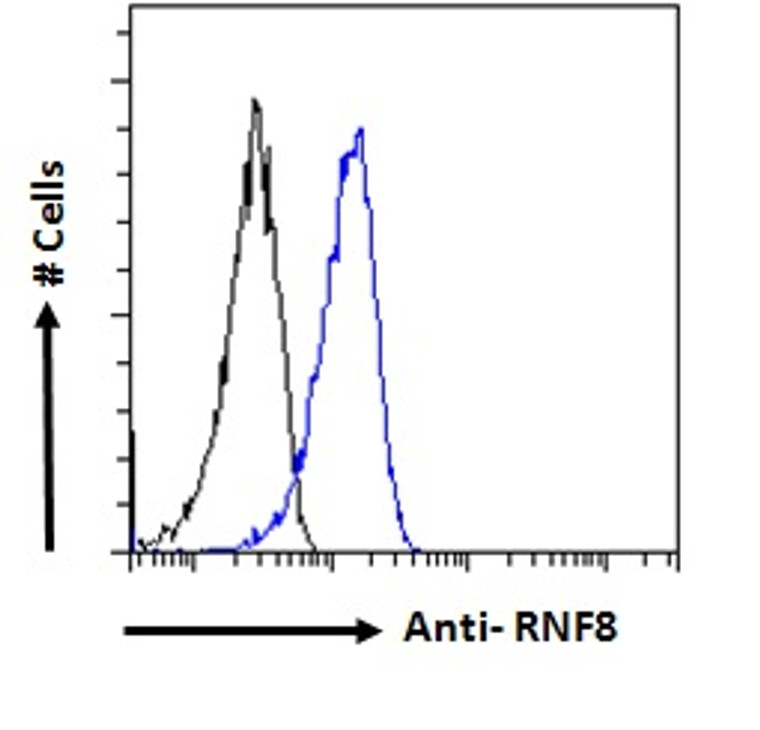| Host: |
Goat |
| Applications: |
Pep-ELISA/WB/FC |
| Reactivity: |
Human |
| Note: |
STRICTLY FOR FURTHER SCIENTIFIC RESEARCH USE ONLY (RUO). MUST NOT TO BE USED IN DIAGNOSTIC OR THERAPEUTIC APPLICATIONS. |
| Short Description: |
Goat polyclonal antibody anti-RNF8 (N-Term) is suitable for use in ELISA, Western Blot and Flow Cytometry research applications. |
| Clonality: |
Polyclonal |
| Conjugation: |
Unconjugated |
| Isotype: |
IgG |
| Formulation: |
0.5 mg/ml in Tris saline, 0.02% sodium azide, pH7.3 with 0.5% bovine serum albumin. NA |
| Purification: |
Purified from goat serum by ammonium sulphate precipitation followed by antigen affinity chromatography using the immunizing peptide. |
| Concentration: |
0.5 mg/mL |
| Dilution Range: |
WB-Recommended concentration 0.5-2µg/mlFC-Flow cytometric analysis of HeLa cells. 10ug/mlELISA-antibody detection limit dilution 1:128000. |
| Storage Instruction: |
Store at-20°C on receipt and minimise freeze-thaw cycles. |
| Gene Symbol: |
RNF8 |
| Gene ID: |
9025 |
| Uniprot ID: |
RNF8_HUMAN |
| Immunogen Region: |
N-Term |
| Accession Number: |
NP_003949.1; NP_898901.1 |
| Specificity: |
This antibody is expected to recognize both reported isoforms (NP_003949.1 and NP_898901.1). |
| Immunogen Sequence: |
GEPGFFVTGDRAG |
| Post Translational Modifications | Autoubiquitinated through 'Lys-48' and 'Lys-63' of ubiquitin. 'Lys-63' polyubiquitination is mediated by UBE2N. 'Lys-29'-type polyubiquitination is also observed, but it doesn't require its own functional RING-type zinc finger. |
| Function | E3 ubiquitin-protein ligase that plays a key role in DNA damage signaling via 2 distinct roles: by mediating the 'Lys-63'-linked ubiquitination of histones H2A and H2AX and promoting the recruitment of DNA repair proteins at double-strand breaks (DSBs) sites, and by catalyzing 'Lys-48'-linked ubiquitination to remove target proteins from DNA damage sites. Following DNA DSBs, it is recruited to the sites of damage by ATM-phosphorylated MDC1 and catalyzes the 'Lys-63'-linked ubiquitination of histones H2A and H2AX, thereby promoting the formation of TP53BP1 and BRCA1 ionizing radiation-induced foci (IRIF). Also controls the recruitment of UIMC1-BRCC3 (RAP80-BRCC36) and PAXIP1/PTIP to DNA damage sites. Also recruited at DNA interstrand cross-links (ICLs) sites and catalyzes 'Lys-63'-linked ubiquitination of histones H2A and H2AX, leading to recruitment of FAAP20/C1orf86 and Fanconi anemia (FA) complex, followed by interstrand cross-link repair. H2A ubiquitination also mediates the ATM-dependent transcriptional silencing at regions flanking DSBs in cis, a mechanism to avoid collision between transcription and repair intermediates. Promotes the formation of 'Lys-63'-linked polyubiquitin chains via interactions with the specific ubiquitin-conjugating UBE2N/UBC13 and ubiquitinates non-histone substrates such as PCNA. Substrates that are polyubiquitinated at 'Lys-63' are usually not targeted for degradation. Also catalyzes the formation of 'Lys-48'-linked polyubiquitin chains via interaction with the ubiquitin-conjugating UBE2L6/UBCH8, leading to degradation of substrate proteins such as CHEK2, JMJD2A/KDM4A and KU80/XRCC5: it is still unclear how the preference toward 'Lys-48'- versus 'Lys-63'-linked ubiquitination is regulated but it could be due to RNF8 ability to interact with specific E2 specific ligases. For instance, interaction with phosphorylated HERC2 promotes the association between RNF8 and UBE2N/UBC13 and favors the specific formation of 'Lys-63'-linked ubiquitin chains. Promotes non-homologous end joining (NHEJ) by promoting the 'Lys-48'-linked ubiquitination and degradation the of KU80/XRCC5. Following DNA damage, mediates the ubiquitination and degradation of JMJD2A/KDM4A in collaboration with RNF168, leading to unmask H4K20me2 mark and promote the recruitment of TP53BP1 at DNA damage sites. Following DNA damage, mediates the ubiquitination and degradation of POLD4/p12, a subunit of DNA polymerase delta. In the absence of POLD4, DNA polymerase delta complex exhibits higher proofreading activity. In addition to its function in damage signaling, also plays a role in higher-order chromatin structure by mediating extensive chromatin decondensation. Involved in the activation of ATM by promoting histone H2B ubiquitination, which indirectly triggers histone H4 'Lys-16' acetylation (H4K16ac), establishing a chromatin environment that promotes efficient activation of ATM kinase. Required in the testis, where it plays a role in the replacement of histones during spermatogenesis. At uncapped telomeres, promotes the joining of deprotected chromosome ends by inducing H2A ubiquitination and TP53BP1 recruitment, suggesting that it may enhance cancer development by aggravating telomere-induced genome instability in case of telomeric crisis. Promotes the assembly of RAD51 at DNA DSBs in the absence of BRCA1 and TP53BP1 Also involved in class switch recombination in immune system, via its role in regulation of DSBs repair. May be required for proper exit from mitosis after spindle checkpoint activation and may regulate cytokinesis. May play a role in the regulation of RXRA-mediated transcriptional activity. Not involved in RXRA ubiquitination by UBE2E2. |
| Protein Name | E3 Ubiquitin-Protein Ligase Rnf8Hrnf8Ring Finger Protein 8Ring-Type E3 Ubiquitin Transferase Rnf8 |
| Database Links | Reactome: R-HSA-5693565Reactome: R-HSA-5693571Reactome: R-HSA-5693607Reactome: R-HSA-69473 |
| Cellular Localisation | NucleusCytoplasmMidbodyChromosomeTelomereRecruited At Uncapped TelomeresFollowing Dna DamageSuch As Double-Strand BreaksRecruited To The Sites Of DamageDuring ProphaseConcomitant With Nuclear Envelope BreakdownLocalizes Throughout The CellWith A Dotted PatternIn TelophaseAgain In The Nucleus And Also With A Discrete Dotted Pattern In The CytoplasmIn Late Telophase And During CytokinesisLocalizes In The Midbody Of The Tubulin Bridge Joining The Daughter CellsDoes Not Seem To Be Associated With Condensed Chromosomes At Any Time During The Cell CycleDuring SpermatogenesisSequestered In The Cytoplasm By Piwil1: Rnf8 Is Released Following Ubiquitination And Degradation Of Piwil1 |
| Alternative Antibody Names | Anti-E3 Ubiquitin-Protein Ligase Rnf8 antibodyAnti-Hrnf8 antibodyAnti-Ring Finger Protein 8 antibodyAnti-Ring-Type E3 Ubiquitin Transferase Rnf8 antibodyAnti-RNF8 antibodyAnti-KIAA0646 antibody |
Information sourced from Uniprot.org
12 months for antibodies. 6 months for ELISA Kits. Please see website T&Cs for further guidance








